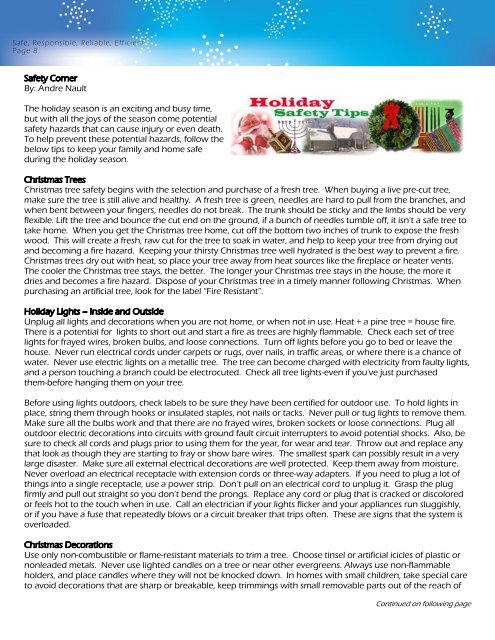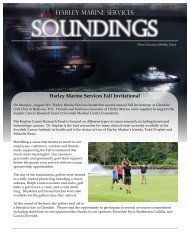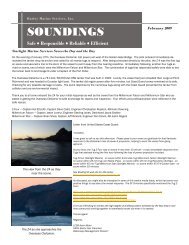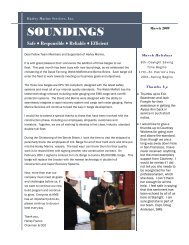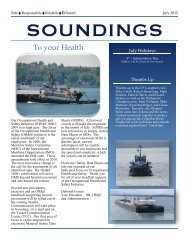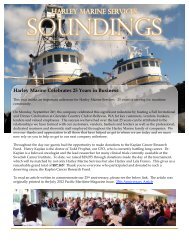December - Harley Marine Services, Inc.
December - Harley Marine Services, Inc.
December - Harley Marine Services, Inc.
Create successful ePaper yourself
Turn your PDF publications into a flip-book with our unique Google optimized e-Paper software.
Safe, Responsible, Reliable, Efficient<br />
Page 8<br />
Safety Corner<br />
By: Andre Nault<br />
The holiday season is an exciting and busy time,<br />
but with all the joys of the season come potential<br />
safety hazards that can cause injury or even death.<br />
To help prevent these potential hazards, follow the<br />
below tips to keep your family and home safe<br />
during the holiday season.<br />
Christmas Trees<br />
Christmas tree safety begins with the selection and purchase of a fresh tree. When buying a live pre-cut tree,<br />
make sure the tree is still alive and healthy. A fresh tree is green, needles are hard to pull from the branches, and<br />
when bent between your fingers, needles do not break. The trunk should be sticky and the limbs should be very<br />
flexible. Lift the tree and bounce the cut end on the ground, if a bunch of needles tumble off, it isn’t a safe tree to<br />
take home. When you get the Christmas tree home, cut off the bottom two inches of trunk to expose the fresh<br />
wood. This will create a fresh, raw cut for the tree to soak in water, and help to keep your tree from drying out<br />
and becoming a fire hazard. Keeping your thirsty Christmas tree well hydrated is the best way to prevent a fire.<br />
Christmas trees dry out with heat, so place your tree away from heat sources like the fireplace or heater vents.<br />
The cooler the Christmas tree stays, the better. The longer your Christmas tree stays in the house, the more it<br />
dries and becomes a fire hazard. Dispose of your Christmas tree in a timely manner following Christmas. When<br />
purchasing an artificial tree, look for the label “Fire Resistant”.<br />
Holiday Lights – Inside and Outside<br />
Unplug all lights and decorations when you are not home, or when not in use. Heat + a pine tree = house fire.<br />
There is a potential for lights to short out and start a fire as trees are highly flammable. Check each set of tree<br />
lights for frayed wires, broken bulbs, and loose connections. Turn off lights before you go to bed or leave the<br />
house. Never run electrical cords under carpets or rugs, over nails, in traffic areas, or where there is a chance of<br />
water. Never use electric lights on a metallic tree. The tree can become charged with electricity from faulty lights,<br />
and a person touching a branch could be electrocuted. Check all tree lights-even if you've just purchased<br />
them-before hanging them on your tree.<br />
Before using lights outdoors, check labels to be sure they have been certified for outdoor use. To hold lights in<br />
place, string them through hooks or insulated staples, not nails or tacks. Never pull or tug lights to remove them.<br />
Make sure all the bulbs work and that there are no frayed wires, broken sockets or loose connections. Plug all<br />
outdoor electric decorations into circuits with ground fault circuit interrupters to avoid potential shocks. Also, be<br />
sure to check all cords and plugs prior to using them for the year, for wear and tear. Throw out and replace any<br />
that look as though they are starting to fray or show bare wires. The smallest spark can possibly result in a very<br />
large disaster. Make sure all external electrical decorations are well protected. Keep them away from moisture.<br />
Never overload an electrical receptacle with extension cords or three-way adapters. If you need to plug a lot of<br />
things into a single receptacle, use a power strip. Don’t pull on an electrical cord to unplug it. Grasp the plug<br />
firmly and pull out straight so you don’t bend the prongs. Replace any cord or plug that is cracked or discolored<br />
or feels hot to the touch when in use. Call an electrician if your lights flicker and your appliances run sluggishly,<br />
or if you have a fuse that repeatedly blows or a circuit breaker that trips often. These are signs that the system is<br />
overloaded.<br />
Christmas Decorations<br />
Use only non-combustible or flame-resistant materials to trim a tree. Choose tinsel or artificial icicles of plastic or<br />
nonleaded metals. Never use lighted candles on a tree or near other evergreens. Always use non-flammable<br />
holders, and place candles where they will not be knocked down. In homes with small children, take special care<br />
to avoid decorations that are sharp or breakable, keep trimmings with small removable parts out of the reach of<br />
Continued on following page


